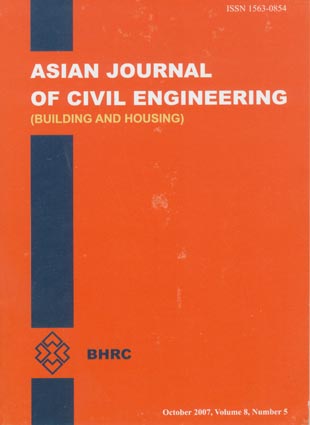فهرست مطالب

Asian journal of civil engineering
Volume:8 Issue: 5, October 2007
- 102 صفحه،
- تاریخ انتشار: 1386/12/10
- تعداد عناوین: 8
-
-
Page 479Test data are presented on the shear strength of a series of reinforced cement concrete (RCC) deep beams with three steel fiber volume fractions (0, 1.0 and 1.25%), three shear span toeffective depth ratios (0.75, 1.0 and 1.25) and three combinations of web reinforcement. A total of 18 beams were tested to failure under two-point top loading. The test results indicate that the fibers have significant influence on the shear strength of a longitudinally reinforced concrete beams. Shear strength increases with increasing fiber volume and decreasing shear span to-effective depth ratio. Steel fibers can replace the conventional web reinforcement in RCC deep beams.
-
Page 491The objective of this paper presents the results of subtask dealing with the bond behaviour study of the reinforcement systems under monotonic loading pull-out tests. This numerical method is based on the slip and the bond stress distributions through the anchored length of the bar in the concrete block. The work refers, especially to the implementation of reinforcing bars and bond-slip models between steel and concrete in the developed finite element program. For the application of the proposed method, three analytical expressions of bond-slip relationship are selected. The obtained results are presented and commented with the fundamental characteristics of plain concrete and reinforced concrete members. The bond models in contribution with concrete and reinforcing steel provide a relativity good representation of bond-zone system responses.
-
Page 507Structural standards and codes of practice are reviewed continuously and improvements are implemented as research findings reveal more accurate methods of design. Design fortorsion unlike design for shear, bending, and axial force, which have been perfected over the years, has not attracted as much attention and is in a rather weaker state. This paper reviews the provisions of the current standards in relation to torsion of reinforced concrete beams and highlights their weaknesses and strengths. A couple of important parameters are introduced and some limits on them are proposed outside of which methods of current standards are better not to be used.
-
Page 521The complexity of the geometrical shape in reinforced concrete amplified the difficulties ofshearing resistance in the boundaries limits state in particular for a section, which issubmitted to the eccentrited biaxial loading (biaxial force plus bending).The difficulties in this study results in the determination of the ultimate forces Nu, Muxand Muy and the relationship between them. These difficulties are essentially du to thegeometrical shape, the steel disposition and the law behaviour of the concrete and steel. The main objectif of this paper is to present a methodological study based on the integration numerical method that would determine the equations of the interaction curves fitting for the determination of the steel sections and the verification of the shearing resistance.
-
Page 531This paper describes the service life of the reinforced concrete (RC) structures in chlorideladen environments. Presence of chloride ions is the most important causes of reinforcingsteel corrosion and the subsequent failure of the whole structure. In this paper, the rate ofchloride transport in the concrete is defined using Fick’s second law of diffusion. Variousstages of corrosion process are defined base on the available models. A stochastic model isintroduced for RC structures corrosion initiation period and cover cracking time period. It isconcluded that a “Lognormal” distribution might best describe the initiation period ofcorrosion. Moreover, it is found that the “Lognormal” and “Normal” distributions coulddefine the cracking time of RC structures elements appropriately.
-
Page 549The shear capacity of the concrete beams having stirrups is assumed as the sum of individualcontributions of both the concrete and shear reinforcement. Different international building codes have suggested empirical relations for both of these contributions. In this research seventy beams with five values of longitudinal reinforcement and seven values of shear span to depth (a/d) ratios were tested in two sets of thirty five beams each, without and with shear reinforcement to study the contribution of the stirrups in resisting the shear. The beams were tested under the concentrated load at the mid span. The test results were analyzed for the contribution of stirrups, the effect of longitudinal steel and shear span to depth a/d ratios. It has been shown by the results that the assumption of summing the individual contribution of steel and concrete for the shear strength of reinforced beams is not proved.
-
Page 563While cracks and corrosion can be detected visually, honeycomb damage cannot be detected by observation with the naked eye. In this study methods of detecting and locating honeycomb damage using three operator algorithms were compared. Honeycomb blocks were prepared and placed at predetermined locations along reinforced concrete beams with 1200×75×125mm size. Honeycombs were located in the beam near one of the supports, in between mid span and support, at mid span, at symmetrical locations and randomly. A total of five damaged beams were prepared for the studies; with one beam prepared for the purpose of control. Modal testing method was used to detect the honeycombs. The test was done using a shaker to excite input to the beam. Eigenvalue data from the modal testing was used to detect the presence of honeycombs in the reinforced concrete beams. Eigenvector data from modal testing were used for detecting honeycomb locations. Eigenvector values were post-processed for detecting these locations. The best results were obtained using the Geometric Mean Operator.
-
Page 573In this paper, an attempt has been taken to find out optimum thickness of edge-supported slabs. To arrive at optimum solution using artificial neural network based on back-propagation network, a number of architectures such as 5-15-25-35-45-55-5; 5-25-35-45-55-65-85-105-5 and 5-35-45-65-75-85-5 with different number of hidden layers and hidden nodes or neuron were tried. Among them, 5-25-35-45-55-65-85-105-5 is found to have the least errors.


